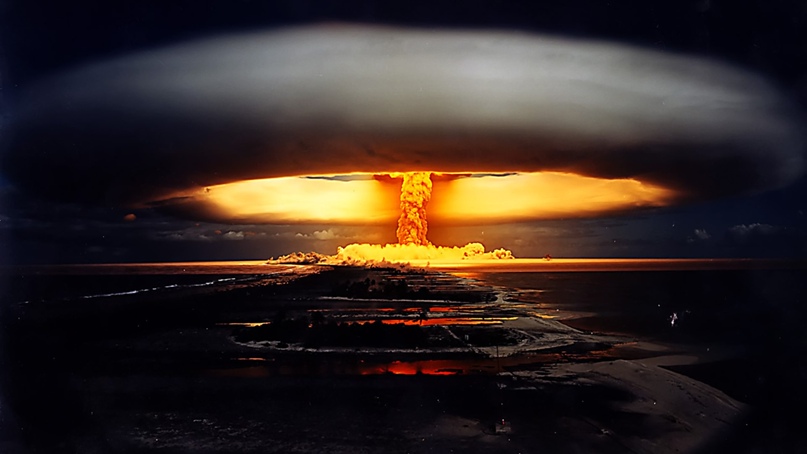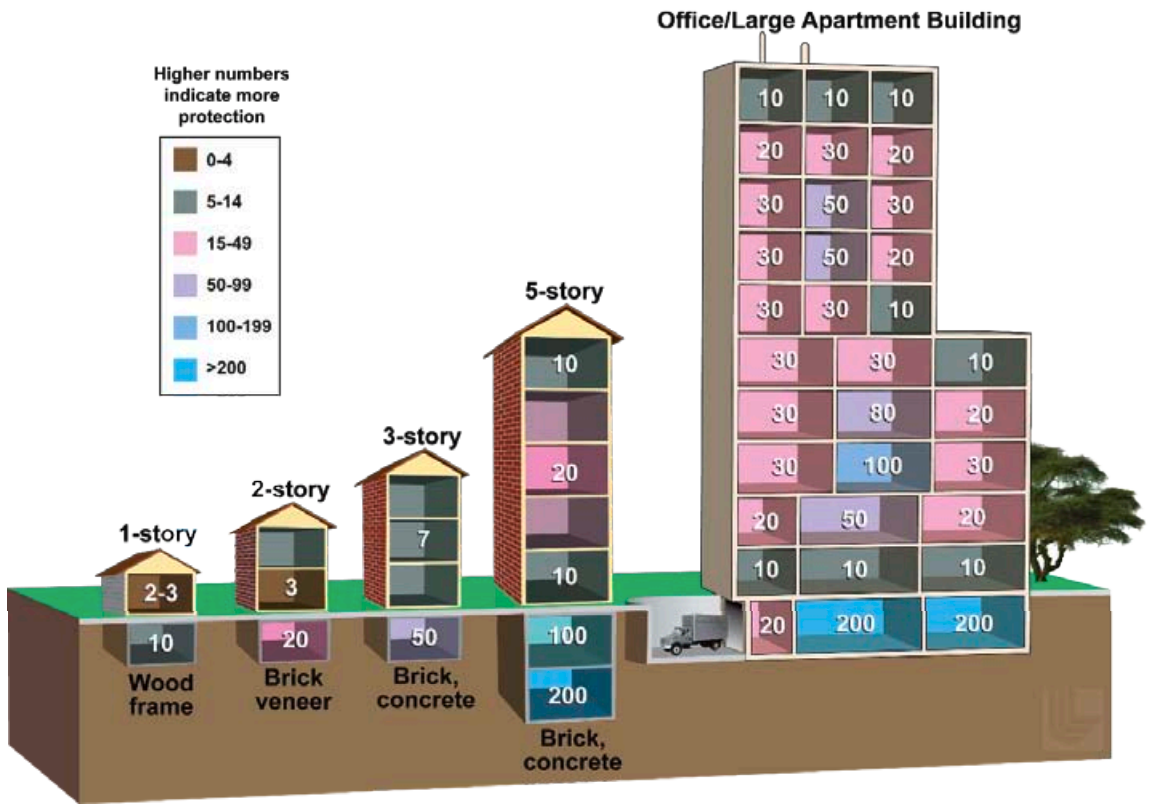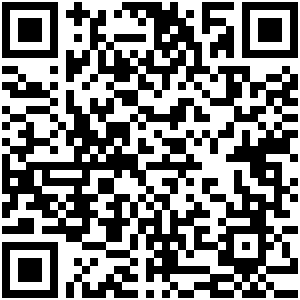 A nuclear blast is an explosion with intense light and heat, a damaging pressure wave, and widespread radioactive material that can contaminate the air, water, and ground surfaces for miles around. A nuclear device can range from a weapon carried by an intercontinental missile launched by a hostile nation or terrorist organization, to a small portable nuclear device transported by an individual. All nuclear devices cause deadly effects when exploded, including blinding light, intense heat (thermal radiation), initial nuclear radiation, blast, fires started by the heat pulse and secondary fires caused by the destruction.
A nuclear blast is an explosion with intense light and heat, a damaging pressure wave, and widespread radioactive material that can contaminate the air, water, and ground surfaces for miles around. A nuclear device can range from a weapon carried by an intercontinental missile launched by a hostile nation or terrorist organization, to a small portable nuclear device transported by an individual. All nuclear devices cause deadly effects when exploded, including blinding light, intense heat (thermal radiation), initial nuclear radiation, blast, fires started by the heat pulse and secondary fires caused by the destruction.
The nuclear threat present during the Cold War has NOT diminished. The danger of a massive strategic nuclear attack on the United States is predicted by experts to be much more likely today. Under the prevailing geo-political climate, it is a virtual certainity. The possibility also remains that a terrorist could obtain access to a nuclear weapon. Called improvised nuclear devices (IND), these are generally smaller, less powerful weapons than we traditionally envision. While experts may predict that a nuclear attack is less likely than other types of disasters, it is still important to know the simple steps that can save your life and the life of your family.
Hazards of Nuclear Devices
Prepare yourself, your family and your property for the hazards of nuclear devices.
If there were threat of an attack, people living near potential targets could be advised to evacuate or they could decide on their own to evacuate to an area not considered a likely target. Protection from radioactive fallout would require taking shelter in an underground area or in the middle of a large building.
In general, potential targets include
-
Strategic missile sites and military bases.
-
Centers of government such as Washington, DC, and state capitals.
-
Important transportation and communication centers.
-
Manufacturing, industrial, technology, and financial centers.
-
Petroleum refineries, electrical power plants, and chemical plants.
-
Major ports and airfields.
The three factors for protecting oneself from radiation and fallout are distance, shielding and time.
-
Distance - the more distance between you and the fallout particles, the better. An underground area such as a home or office building basement offers more protection than the first floor of a building. A floor near the middle of a high-rise may be better, depending on what is nearby at that level on which significant fallout particles would collect. Flat roofs collect fallout particles so the top floor is not a good choice, nor is a floor adjacent to a neighboring flat roof.
-
Shielding - the heavier and denser the materials - thick walls, concrete, bricks, books and earth - between you and the fallout particles, the better.
-
Time - fallout radiation loses its intensity fairly rapidly. In time, you will be able to leave the fallout shelter. Radioactive fallout poses the greatest threat to people during the first two weeks, by which time it has declined to about 1 percent of its initial radiation level.
Remember that any protection, however temporary, is better than none at all, and the more shielding, distance and time you can take advantage of, the better.
The extent, nature and arrival time of these hazards are difficult to predict. The geographical dispersion of hazard effects will be defined by the following:
-
Size of the device. A more powerful bomb will produce more distant effects.
-
Height above the ground the device was detonated. This will determine the extent of blast effects.
-
Nature of the surface beneath the explosion. Some materials are more likely to become radioactive and airborne than others. Flat areas are more susceptible to blast effects.
-
Existing meteorological conditions. Wind speed and direction will affect arrival time of fallout; precipitation may wash fallout from the atmosphere.
In addition to other effects, a nuclear weapon detonated in or above the earth’s atmosphere can create an electromagnetic pulse (EMP), a high-density electrical field. An EMP acts like a stroke of lightning but is stronger, faster, and shorter. An EMP can seriously damage electronic devices connected to power sources or antennas. This includes communication systems, computers, electrical appliances, and automobile or aircraft ignition systems. The damage could range from a minor interruption to actual burnout of components. Most electronic equipment within 1,000 miles of a high-altitude nuclear detonation could be affected. Battery-powered radios with short antennas generally would not be affected. Although an EMP is unlikely to harm most people, it could harm those with pacemakers or other implanted electronic devices.
Even if individuals are not close enough to the nuclear blast to be affected by the direct impacts, they may be affected by radioactive fallout. Any nuclear blast results in some fallout. Blasts that occur near the earth’s surface create much greater amounts of fallout than blasts that occur at higher altitudes. This is because the tremendous heat produced from a nuclear blast causes an up-draft of air that forms the familiar mushroom cloud. When a blast occurs near the earth’s surface, millions of vaporized dirt particles also are drawn into the cloud. As the heat diminishes, radioactive materials that have vaporized condense on the particles and fall back to Earth. The phenomenon is called radioactive fallout. This fallout material decays over a long period of time, and is the main source of residual nuclear radiation.
Fallout from a nuclear explosion may be carried by wind currents for hundreds of miles if the right conditions exist. Effects from even a small portable device exploded at ground level can be potentially deadly.
Nuclear radiation cannot be seen, smelled, or otherwise detected by normal senses. Radiation can only be detected by radiation monitoring devices. This makes radiological emergencies different from other types of emergencies, such as floods or hurricanes. Monitoring can project the fallout arrival times, which will be announced through official warning channels. However, any increase in surface build-up of gritty dust and dirt should be a warning for taking protective measures.
This Is How You Actually Survive a Nuclear Attack
Before a Nuclear Blast
The following are things you can do to protect yourself, your family and your property in the event of a nuclear blast.
-
Build an Emergency Supply Kit, which includes items like non-perishable food, water, a battery-powered or hand-crank radio, extra flashlights and batteries. You may want to prepare a kit for your workplace and a portable kit to keep in your car in case you are told to evacuate.
-
Make a Family Emergency Plan. Your family may not be together when disaster strikes, so it is important to know how you will contact one another, how you will get back together and what you will do in case of an emergency.Find out from officials if any public buildings in your community have been designated as fallout shelters. If none have been designated, make your own list of potential shelters near your home, workplace and school. These places would include basements or the windowless center area of middle floors in high-rise buildings, as well as subways and tunnels.
-
Plan places where your family will meet, both within and outside of your immediate neighborhood.
-
Knowing your community's warning systems and disaster plans, including evacuation routes.
-
-
If you live in an apartment building or high-rise, talk to the manager about the safest place in the building for sheltering and about providing for building occupants until it is safe to go out.
-
During periods of heightened threat increase your disaster supplies to be adequate for up to two weeks.
Taking shelter during a nuclear blast is absolutely necessary. There are two kinds of shelters - blast and fallout. The following describes the two kinds of shelters:
-
Blast shelters are specifically constructed to offer some protection against blast pressure, initial radiation, heat and fire. But even a blast shelter cannot withstand a direct hit from a nuclear explosion.
-
Fallout shelters do not need to be specially constructed for protecting against fallout. They can be any protected space, provided that the walls and roof are thick and dense enough to absorb the radiation given off by fallout particles.
During a Nuclear Blast
The following are guidelines for what to do in the event of a nuclear explosion.
-
Listen for official information and follow the instructions provided by emergency response personnel. Based on what is known about the threat, you may be asked to take shelter, go to a specific location or evacuate the area.
-
If an attack warning is issued, take cover as quickly as you can, below ground if possible, and stay there until instructed to do otherwise.
-
Find the nearest building, preferably built of brick or concrete, and go inside to avoid any radioactive material outside.
-
If better shelter, such as a multi-story building or basement can be reached within a few minutes, go there immediately.
-
Go as far below ground as possible or in the center of a tall building. The goal is to put as many walls and as much concrete, brick and soil between you and the radioactive material outside.
-
Stay where you are, even if you are separated from your family. Inside is the safest place for all people in the impacted area. It can save your life.
-
During the time with the highest radiation levels it is safest to stay inside, sheltered away from the radioactive material outside.
-
Radiation levels are extremely dangerous after a nuclear detonation but the levels reduce rapidly.
-
Expect to stay inside for at least 24 hours unless told otherwise by authorities.
-
When evacuating is in your best interest, you will be instructed to do so. All available methods of communication will be used to provide news and / or instructions.
-
People in the path of the radioactive material - downwind from the detonation - may also be asked to take protective measures.
If you are caught outside and unable to get inside immediately:
-
Do not look at the flash or fireball - it can blind you.
-
Take cover behind anything that might offer protection.
-
Lie flat on the ground and cover your head. If the explosion is some distance away, it could take 30 seconds or more for the blast wave to hit.
-
Take shelter as soon as you can, even if you are many miles from ground zero where the attack occurred - radioactive fallout can be carried by the winds for hundreds of miles. Remember the three protective factors: Distance, shielding and time.
-
If you were outside during or after the blast, get clean as soon as possible, to remove radioactive material that may have settled on your body.
-
Remove your clothing to keep radioactive material from spreading. Removing the outer layer of clothing can remove up to 90% of radioactive material.
-
If practical, place your contaminated clothing in a plastic bag and seal or tie the bag. Place the bag as far away as possible from humans and animals so that the radiation it gives off does not affect others.
-
When possible, take a shower with lots of soap and water to help remove radioactive contamination. Do not scrub or scratch the skin.
-
Wash your hair with shampoo or soap and water. Do not use conditioner in your hair because it will bind radioactive material to your hair, keeping it from rinsing out easily.
-
Gently blow your nose and wipe your eyelids and eyelashes with a clean wet cloth. Gently wipe your ears.
-
If you cannot shower, use a wipe or clean wet cloth to wipe your skin that was not covered by clothing.
Building as Shielding

Numbers in this graphic stand for a 'dose reduction factor.' A dose reduction factor of 10 means that a person in that area would get 1/10th of the dose of a person in the open. A dose reduction factor of 200 means that a person in that area would receive 1/200th of the dose of a person out in the open.
After a Nuclear Blast
Decay rates of the radioactive fallout are the same for any size nuclear device. However, the amount of fallout will vary based on the size of the device and its proximity to the ground. Therefore, it might be necessary for those in the areas with highest radiation levels to shelter for up to a month.
The heaviest fallout would be limited to the area at or downwind from the explosion and 80 percent of the fallout would occur during the first 24 hours.
People in most of the areas that would be affected could be allowed to come out of shelter within a few days and, if necessary, evacuate to unaffected areas.
Remember the following when returning home:
-
Keep listening to the radio and television for news about what to do, where to go and places to avoid.
-
Stay away from damaged areas. Stay away from areas marked “radiation hazard” or “HAZMAT.” Remember that radiation cannot be seen, smelled or otherwise detected by human senses.
Additional guidelines for recovering from disaster.
Further Reading
- Nuclear Attack. Document providing preparation guidance for a nuclear threat.
- Consequences of Nuclear War
- The Lethality of Nuclear Weapons
- Climate Scientist Michael Mills Describes the Devastation of a Nuclear Detonation
- Is Nuclear War Survivable?
- Nuclear War Survival Skills
- Nuclear War, Nuclear Winter, and Human Extinction
Related Websites
Find additional information on how to plan and prepare for a nuclear blast and learn about available resources by visiting the following websites:
- Nuclear War Survival Skills
- Federal Emergency Management Agency
- American Red Cross
- Center for Disease Control and Prevention - Radiation Emergencies
- Center for Disease Control and Prevention - Mass Casualty Events
- Environmental Protection Agency
- National Radiation Map
- NUKEMAP
Listen to Local Officials
Learn about the emergency plans that have been established in your area by your state and local government. In any emergency, always listen to the instructions given by local emergency management officials.
Could You Survive a Fallout
{vembed Y=YvGlBFjxvgY}
What if the World Ended? Nuclear Winter
{vembed Y=CJLMCT1aXRM}






